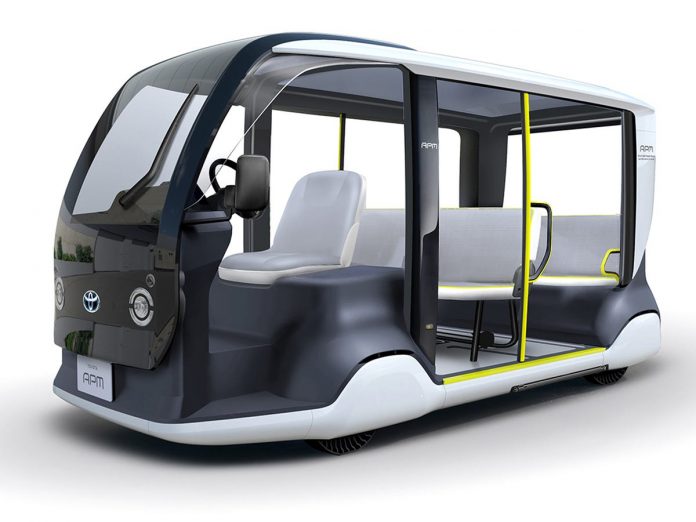
Media Release
Toyota announced today it will supply up to 20 specially designed “Tokyo 2020 Version” e-Palette vehicles to support athlete mobility at the Olympic and Paralympic Games Tokyo 2020.
The vehicles will operate in the automated, loop-line transportation Toyota will provide in the Olympic and Paralympic villages for athletes and related staff.
Takahiro Muta, development leader for the unique version of the e-Palette for Tokyo 2020, said the battery-electric, automated vehicles have been adapted specifically for use during the Games based in part on feedback from athletes about their mobility needs.
“Olympic and Paralympic athletes work tirelessly to achieve the impossible, and we wanted to provide them with a vehicle specifically designed and calibrated to fit their mobility needs during Tokyo 2020,” Mr Muta said.
“Throughout the development process, athletes, especially Paralympians, helped us to better understand how we could adapt and upgrade the e-Palette to better meet the need for simple, convenient and comfortable mobility.
“We are proud to work with them on a vehicle that will not just move athletes physically throughout the Olympic and Paralympic Villages but will also offer them new opportunities to interact with others, share new experiences, and be moved emotionally.”
First announced in 2018, e-Palette is Toyota’s first vehicle developed specifically for autonomous mobility as a service (Autono-MaaS1) applications. It reflects Toyota’s ongoing transition to a mobility company and combines electrification, connected networks and advanced driving technologies to support new shared mobility businesses and business models.
The Tokyo 2020 Version e-Palette has been adapted to meet the unique needs of the Olympic and Paralympic Village, featuring large doors and electric ramps to allow groups of athletes to board quickly and easily. The vehicle will be controlled by an automated driving system capable of operating up to 19 km/h at SAE level2 4, supported by an on-board safety operator.
Deploying the e-Palette to support athlete and staff mobility is a key element of Toyota’s program to provide advanced mobility solutions for Tokyo 2020 as the first worldwide mobility partner of the Olympic and Paralympic Games.
Toyota plans to leverage the knowledge gained from operating e-Palette at Tokyo 2020 to continue developing the vehicle to support future Mobility-as-a-Service applications.
The Tokyo 2020 Version will be revealed and exhibited at Toyota’s booth during the 2019 Tokyo Motor Show.
Overview of the e-Palette “Tokyo 2020 Version”
Designed for comfortable mobility
- Designed with front/rear symmetry, a distinctive cube shape, and wheels at the four corners, the vehicle offers expansive and comfortable interior space.
- Reflecting Toyota’s commitment to providing “Mobility for All”, it includes handrails and seats that are easy to use regardless of height; the vehicle also features floor, trim, seats, and other components with colour contrasts that assist people with colour-blindness.
Enabling quick and easy entry/exit for passengers
- The e-Palette is equipped with large sliding doors, low floors, electric ramps, and an Arrival Control3 system for use when approaching destinations to enable passengers, including those in wheelchairs, to enter and exit quickly and easily.
- With its long wheelbase and flat floor, the vehicle can transport up to four passengers in wheelchairs along with additional standing passengers at one time.
Low-speed automated driving with a focus on safety
- The e-Palette is equipped with a specially designed automated driving system that includes control hardware, software and advanced sensors such as cameras and LiDAR. Combined with high-accuracy 3D mapping and an operation management system, e-Palette will realise low-speed automated driving at SAE level 4.
- To support safe operation, the e-Palette features an external human-machine interface designed to assist communication with those around the vehicle, including pedestrians, during automated driving. Headlamps on the front and rear of the vehicle mimic eye contact to inform pedestrians of vehicle actions.
- The automated driving system constantly monitors for obstacles across a full 360-degree field of vision around the vehicle and operates at a speed appropriate and in accordance with the surrounding environment. As a preventative measure, an on-board safety operator will also monitor the vehicle’s movement and be prepared to take control if necessary.
MAIN SPECIFICATIONS4
| Length | 5,255 mm |
| Width | 2,065 mm |
| Height | 2,760 mm |
| Wheelbase | 4,000 mm |
| Passengers | Up to 20 (including operator) or Up to 4 wheelchairs + 7 standing passengers |
| Range | 150 km (approx..) |
| Max. speed | 19 km/h |
1 Combination of “autonomous” and “mobility as a service” describing Toyota’s mobility services using automated driving vehicles.
2 SAE Level references can be found here.
3 It controls the vehicle to stop at the designated boarding and alighting locations and minimises the gap to the bus stop itself.
4 Dimensions are approximate and are subject to individual vehicle variances.


















